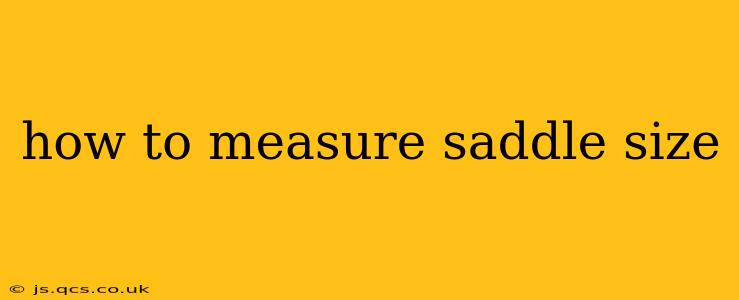Finding the right saddle size is crucial for comfort and performance, whether you're a seasoned cyclist or just starting out. An ill-fitting saddle can lead to discomfort, pain, and even injury. This guide will walk you through how to accurately measure your saddle size and ensure a perfect fit.
What Determines Saddle Size?
Before diving into measurements, it's important to understand that saddle size isn't solely determined by a single measurement. While sit bone width is a key factor, your riding style, flexibility, and personal preferences also play a significant role. A saddle that's perfectly comfortable for one cyclist might be uncomfortable for another, even if they have the same sit bone width.
How to Measure Sit Bone Width: The Key Measurement
Sit bone width, also known as ischial tuberosity width, is the distance between your sit bones (ischial tuberosities). These are the two bony points you feel when you sit down. Accurately measuring this is the foundation for choosing the right saddle size. Here's how to do it:
-
Gather your materials: You'll need a hard, flat surface (like a wooden floor), a piece of thick cardboard or stiff paper, and a measuring tape.
-
Sit on the cardboard: Sit on the cardboard or paper with your weight evenly distributed. Make sure your posture is natural and relaxed. Avoid tilting or shifting your weight.
-
Mark your sit bones: Carefully stand up. You should see two distinct indentations on the cardboard or paper where your sit bones were. Mark these indentations clearly.
-
Measure the distance: Use the measuring tape to measure the distance between the two marked points. This is your sit bone width.
-
Consult saddle sizing charts: Most saddle manufacturers provide sizing charts that correlate sit bone width with saddle width. Use this measurement to narrow down your saddle options. Remember that these are guidelines, and personal preference still matters.
What if I Don't Have a Saddle Sizing Chart?
Some brands may not offer explicit sizing charts. In these cases, contacting the manufacturer's customer service is always a good idea. They might have additional guidance or recommendations based on your sit bone measurement. You can also consult with a local bike shop; their staff can provide expert advice and often have tools to assist with saddle fitting.
How important is accurate sit bone width measurement?
Accurate measurement of your sit bone width is extremely important for selecting a saddle that properly supports your sit bones, promoting comfort and preventing pressure points. An incorrectly sized saddle can lead to numbness, discomfort, and potential long-term health issues.
What other factors should I consider besides sit bone width?
Besides sit bone width, consider your riding style (road, mountain biking, gravel), riding posture (aggressive, relaxed), and personal preference. Some saddles are designed for specific riding styles and offer different levels of padding and support. It's also important to test ride different saddles to find what feels most comfortable for you.
Can I use a saddle sizing kit instead of measuring myself?
Saddle sizing kits are available and can provide a convenient way to determine your sit bone width. These kits often involve sitting on a specialized device that measures the distance between your sit bones directly. While these kits can be helpful, it's still recommended to cross-reference the results with saddle manufacturer sizing charts.
What if my sit bone measurement falls between sizes?
If your sit bone measurement falls between two sizes, it's generally recommended to choose the larger size. A slightly wider saddle will provide more support and is less likely to cause discomfort than a saddle that's too narrow.
Finding the perfect saddle requires a combination of accurate measurement and personal preference. Don't hesitate to try out different saddles to find the one that provides the optimal combination of comfort and support. Remember to consult with a professional bike fitter for personalized advice.
